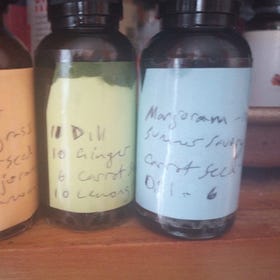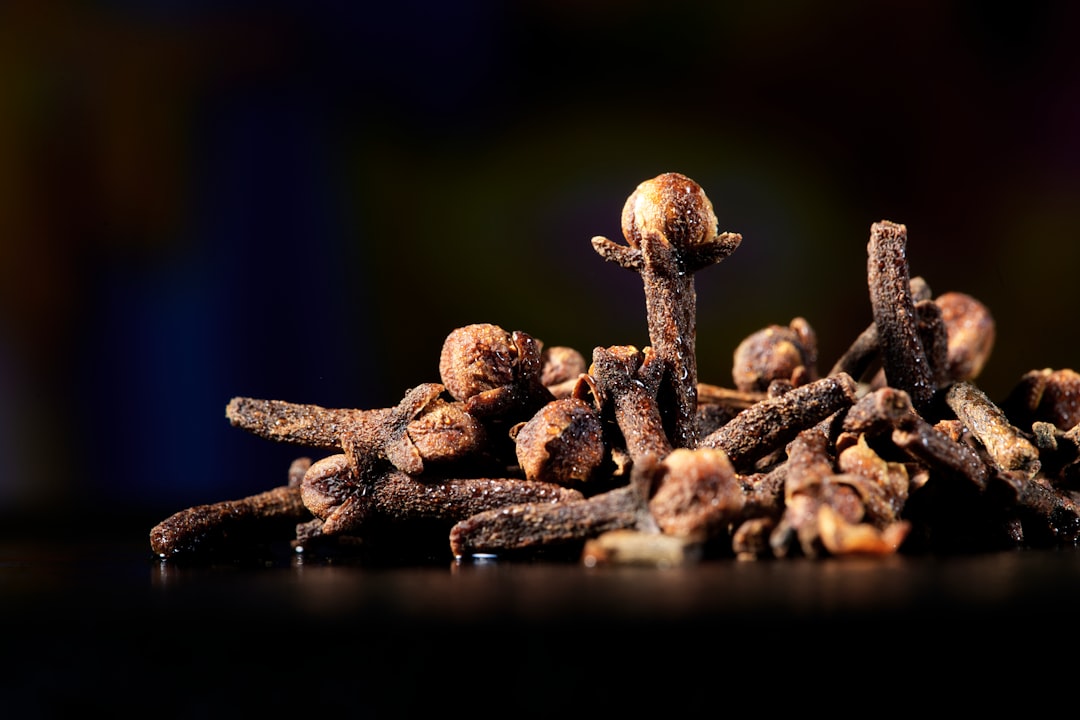Essential oil soup or salad flavor drops
Herbs used in Herbes de Provence are a focus along with caraway, celery and cardamom seed oils. Essential Oil Book Club
All of my essential oil salad/soup blends got emptied and I miss them. Using essential oils is another task to do in daily self-care. Anoint the body with healthy oils daily in self-care routines of varied sorts - topical and edible. Cooking with pure essential oils can be tricky as they are so strong it is easy to overpower a recipe, let alone consider adding it to a single serving. By making a diluted blend or single oil, I can add some of the dilution with less worry about adding WAY too much of the essential oil/s to the food or beverage.
This post is about edible essential oils which includes any pure essential oils that were made from food type herbs or seeds. Basically, if the herb/seed the oil is made from is a food, then the essential oil should also be a food - unless it wasn’t made with pure processing techniques. If an essential oil bottle says for topical use only it might be due to FDA labeling laws being so picky, but inedible solvents might have been used or added to dilute it. Look for a product label that says 100% pure, no solvents used in the processing, and which is not marked as a perfume product. A company website should have information about their quality control process.
How much of a dilution?
I did some math on this recipe topic in a previous post, so I am skipping the math - the dilution ratio which I have found easy to use in the kitchen, is about 50-80 drops of essential oils (5 mL ~ 85 drops) in a one-ounce (30 mL) eye dropper bottle filled the rest of the way with fractionated (MCT) coconut oil (leave a little room empty to put the eye dropper back in.
Cooking with essential oils
Experimenting with essential oils in cooking led to a greater appreciation for whole herbs and spices. They add more to a cooked food, more lasting flavor or more full-bodied flavor.
Here are my today’s blends - ginger is being removed from my old trial recipes.
The blends are not rocket science - kitchen science can be mellow. Does it smell and taste good? I am just throwing some oils in bottles with some kitchen common sense involved in the proportions. Oregano oil can be overpowering, and Caraway and Celery are noticeable, wherever they are present. Cardamom is a little cinnamon like but has its own spicy flavor.
Cilantro - 40 drops, Lemongrass - 10, Caraway - 10, Cardamom - 10
Marjoram - 20 drops, Tarragon - 10, Caraway - 10, Celery seed - 6, Cardamom - 15
Summer savory - 20 drops, Tarragon - 10, Rosemary - 10, Celery seed - 10
Oregano - 6, Rosemary - 10, Summer savory - 10, Marjoram - 10, Caraway seed - 6.
Blend #3 and 4 smell great and both include Summer Savory and other herbs used in the traditional blend called Herbes de Provence — Adding the celery or caraway seed adds an extra bitter accent and are essential oils that may be good for liver health.
Summer savory is a pungent herb in the mint family with a flavor similar to thyme and sage. Use in moderation. It blends well with other strong herbs in the mint family like rosemary and oregano. Summer savory is used in the traditional blend called Herbes de Provence. (spiceography.com/cooking-with-summer-savory/)
These blends may be a little mint/salicylate rich for my health. I don’t need a lot to add some flavor to a meal though - 1/4- 1/2 of an eyedropper up to one or two fuller tubes will season a salad or bowl of soup.
“Herbes de Provence is an aromatic mixture of dried Provençal herbs and spices, which traditionally includes thyme, basil, rosemary, tarragon, savory, marjoram, oregano, and bay leaf.
Herbes de Provence are most commonly used in French cuisine, though the flavors also pair well with Mediterranean cuisine.” (masterclass.com)
Blend #2 is going a little more spicey with caraway and celery seed and cardamom.
Blend #1 is heavy on cilantro and the caraway stands out with a lemony backdrop.

Why bother using essential oils in foods or topically or aromatically?
Use essential oils for the same reason as using herbs and spices - to add flavor and to provide health and mood benefits. Mind clarity and decisiveness can be a benefit, not just reduced anxiety. Building with cedarwood and other fragrant woods was part of the Biblical directions that ancient people were directed to follow. Many of the ‘anointing with oil’ rituals would have been the same as “sanitizing surfaces and oneself with oil prior to being allowed in the presence of the ‘Powerful Ones’ ~ ‘alien visitors’ ~ ‘gods’. Cedarwood has mind clearing benefits - clarity of thought would be helpful in your human servants/managers.
This post has details about the aromatic chemicals within the oils, or the whole herbs and spices, which are particularly healing for us.
Healing Spices - a brief book review
Rather than being an Essential Oil book, this book about the benefits and how to use spices in your cooking is worth the library card or purchase price - “Healing Spices - How to Use 50 Everyday and Exotic Spices to Boost Health and Beat Disease”, by Bharat B. Aggarwal, PhD, with Debora Yost, (2011). The recipes look good and are based on the cuisine from around the world but with a focus on southern India cuisine. Ideas for typical use are numerous for each spice/herb and there is one recipe included for each.
While this book is still available as a full-price new book - it appears to have a lot of used copies online available at low prices - making it a good deal. (abebooks) This is a reference book. Each herb/spice section includes a fairly thorough review of medical research regarding the health benefits and the culinary tips share many common uses or blends for the herb.
Towards the end of the book is a section full of recipes from around the world for making your own spice mixes and rubs. Spice rubs are rubbed onto a cut of meat before marinating it or roasting it. A couple pages are devoted to Curry blends from different regional areas. A summary section at the back is included which shows which herbs/spices might help a medical condition and the dose used in a medical study. The book has an index but not a full academic Bibliography of the medical research that is reviewed. I checked the book out of a library, but it would be worth owning.
Addition - I read the introduction - the author worked in the gene tech pharma world and discovered TNF protein. Her background was based in northern India and a culture of home remedies and cooking with spices. She started researching the healing benefits of turmeric on her own - her gene tech pharma world was not interested at the time. Her motivation to write this book - regarding there now being a large body of research showing the healing benefits of herbs and spices - it still isn’t being discussed. People aren’t yet receiving the benefits and in part she thinks it is because they aren’t being told by doctors, but also because they don’t know how to use herbs and spices in the way she grew up with from early childhood.
“These studies haven’t escaped the attention of the FDA and National Institutes of Health (NIH) — but our government isn’t acting fast enough to inform the public that the typical American diet is sorely lacking in spices. They aren’t even mentioned in the USDA’s food pyramid! That’s why I wrote this book.” - Bharat B. Aggarwal, PhD, Jan. 2011
“Spices, the friend of physicians and the pride of cooks.” - King Charlemagne, eighth century
“In a survey of cookbooks by food scientists, 9 percent of recipes contained at least one spice; the average was four.” Where you are dining in the world matters - four would be a low end number of spices in Indian, Indonesian, and Thai cooking, while American recipes might have one or two. (page 8, “Healing Spices - How to Use 50 Everyday and Exotic Spices to Boost Health and Beat Disease, Bharat B. Aggarwal, PhD, Jan. 2011, (abebooks)
Even the Polish list of traditional herbs and spices was generous compared to much of standard American dishes - the end of this post has a lot of recipe and some herb and spice information. Caraway seeds and tamales, and leaf wrapped foods around the world is the muddled theme:
In brief directions for topical or edible use
Essential oils are potent, and caution is needed to use them safely for that reason. They are medicinal and excess for some types can burn the skin or inner mouth if undiluted or not diluted enough for sensitive skin. Younger children and older people may have more skin sensitivity to ‘hotter’ oils like clove oil or cooling oils like mint. Some essential oils are edible but only 1-2 drops per pot of soup - oregano essential oil is intense in flavor and also on skin - it needs to be diluted for topical use.
Oregano essential oil is a very strong antimicrobial, and iron chelator too, and can be used topically diluted in a carrier oil ~ 1 drop to a teaspoon of coconut, almond, or olive oil. The palms and soles of the feet are particularly absorptive and use twice a day can help a patient heal and seems to improve circulation at a local level and may speed healing of bruises.
Generally Regarded as Safe for ‘typical’ use - GRAS - many food oils are considered GRAS. This link has the FDA GRAS list for essential oils and solvent free oleoresins and it includes a lot of plants/oils. What is the typical use may be the catch point. Some oils are better tolerated as edibles than topicals and vice versa. (accessdata.fda.gov)
GRAS link excerpted from this post:
I also mentioned this post with essential oils for liver health - I have had to reduce use of those blends I made with clove essential oil as it seems to have more salicylate than I can tolerate.
Disclaimer: Opinions are my own and the information is provided for educational purposes within the guidelines of Fair Use. While I am a Registered Dietitian this information is not intended to provide individual health guidance. Please see a health professional for individual health care purposes.









This is kind of off topic, but I couldn't think of anyone else who might be interested to send it to!
helpful news snippet of the day - beneficial phytochemicals in black tea are larger than those in green tea, and consequently they stay in the intestine and nourish the gut microbiome, rather than being absorbed to assist the body directly.
this is really helpful, I have a bunch of essential oils that I love but have not been sure how to use them.